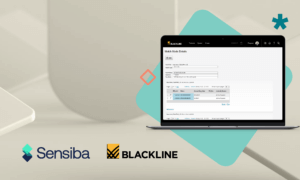In today’s business environment, organizations face the daunting challenge of managing large volumes of financial transactions efficiently and accurately. BlackLine Transaction Matching offers a powerful solution that optimizes the matching process. It enables businesses to streamline operations, enhance financial controls, and reallocate employee resources to increase company value.
BlackLine Transaction Matching Overview
BlackLine Transaction Matching is a robust tool designed to match and reconcile financial transactions, reducing manual effort and mitigating the risk of errors. By automating the matching process, organizations can achieve greater accuracy, speed, and control over their financial data.
Benefits of Transaction Matching
Effective transaction matching offers several benefits.
- Minimizes the likelihood of errors by eliminating manual data entry and the associated risks of data being entered incorrectly or omitted.
- Enhances efficiency by reducing the time and effort required for reconciliations, allowing finance teams to focus on higher value-added tasks.
- Improves transparency and accountability by providing a comprehensive audit trail and supporting regulatory compliance.
Organizations may face challenges when implementing transaction matching tools. Common challenges include data quality issues, complex integrations with existing systems, and the need for proper training and documentation to ensure successful adoption.
Industry Applications
BlackLine Transaction Matching can be applied across various industries, including banking, insurance, retail, healthcare, and manufacturing. Use cases range from bank statement reconciliations and intercompany matching to invoice/purchase order reconciliations and credit card or P-card reconciliations.
We also have experience helping clients match inventory quantities, rather than dollar amounts. The flexibility and scalability of BlackLine Transaction Matching make it adaptable to diverse business needs.
Factors to Consider Before Implementing
Integrating your transaction matching tool with your existing systems is essential for seamless operations. Organizations must ensure compatibility with multiple data sources and establish robust integration interfaces. Moreover, planning for scalability and future growth is crucial, as the volume of transactions and data sources may increase over time.
Similarly, data security and privacy are paramount when implementing transaction matching. Organizations should prioritize data encryption, access controls, and user authentication to safeguard sensitive financial information. Compliance with data protection regulations, regular IT security audits, and risk assessments contribute to maintaining a secure environment.
Preparing for Implementation
To achieve the full potential of effective transaction matching, organizations should do thorough preparation, including process design and establishing clear efficiency goals.
- Gathering necessary data. Before implementing a transaction matching solution, organizations must identify the relevant data sources required for matching. This involves gathering transactional data from different systems, such as ERPs, bank statements, invoices, and subledger systems, and ensuring its availability in a suitable electronic file format.
- Ensuring data quality and consistency. Data quality is vital for accurate matching and the overall success of a matching project. Organizations must perform data cleansing and standardization processes to ensure consistency and integrity across all transactions. This may involve validating data formats, eliminating duplicates, performing lookups to other data sources, and resolving discrepancies.
- Identifying relevant matching criteria. Determining the appropriate matching criteria is crucial for effective transaction matching. Organizations must analyze their specific business requirements and establish matching rules based on process-specific criteria such as transaction amounts, dates, account numbers, and customer names.
Strategies for Optimizing Transaction Matching
To maximize the benefits of transaction matching, organizations can implement several optimization strategies.
Automated Data Extraction
Automated data extraction tools can capture transactional data from various sources, eliminating manual data entry and reducing the risk of errors. By leveraging optical character recognition (OCR) and intelligent data capture techniques, organizations can extract relevant data seamlessly.
Standardizing and Cleansing
Data standardization facilitates accurate matching by ensuring consistent formatting across transactions. By cleansing and validating data, organizations can identify and rectify any anomalies, enhancing the overall quality of the matching process.
Rule-Based and Artificial Intelligence-Based Matching
Look for a transaction matching tool with the flexibility to employ rule-based matching and artificial intelligence techniques. Rule-based matching enables organizations to define specific matching rules based on predefined criteria. Artificial intelligence can also identify patterns and make automated matching decisions, optimizing accuracy and efficiency.
Intelligent Exception Handling
Your transaction matching tool should flag and handle exceptions automatically, reducing the need for manual intervention. By implementing intelligent exception handling, organizations can streamline the resolution process and improve overall matching efficiency.
Real-Time Monitoring and Reporting
Real-time monitoring and reporting capabilities enable organizations to track the progress of the matching process and identify any issues promptly. By leveraging customizable dashboards and scheduled reports, finance teams can gain actionable insights and make informed decisions.
Providing Training and Continual Support
Effective user and administrator training are essential for successful transaction matching adoption and optimization. Organizations should invest in comprehensive training programs to empower users with the necessary knowledge and skills. Furthermore, user-friendly documentation and guides, along with a knowledge sharing platform such as the BlackLine Community, can serve as valuable resources for ongoing support.
Testing for Effectiveness
Thoroughly testing scenarios and benchmarking exercises help validate the accuracy and performance of your transaction matching solution. By simulating various matching scenarios, organizations can identify any gaps or areas for improvement and fine-tune their matching processes accordingly.
Similarly, organizations must prioritize continuous improvement and maintenance to maximize the benefits of their transaction matching tool and processes. Gathering feedback from users and stakeholders, tracking performance, resolving issues, and improving features contribute to an optimized matching process.
Take Your BlackLine Setup to the Next Level
Implementing and optimizing a transaction matching tool empowers organizations to achieve greater efficiency, accuracy, and control over their financial data. By leveraging automation, data standardization, artificial intelligence, and exception handling, businesses can materially streamline operations and enhance financial controls. With comprehensive training, integration, and ongoing maintenance, organizations can unlock the full potential of effective transaction matching.
Start optimizing your BlackLine transaction matching today by scheduling time with one of Sensiba’s certified implementation experts. We’ll review your implementation and help you revolutionize your financial reconciliation processes. The goal of our BlackLineBoost is to save you time and resources while ensuring accuracy and compliance.















